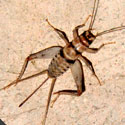October
Oct 13, 2011 Killdeer with their eyesight well adapted to dim conditons were active and noisy much of the night using light from the nearly full moon to hunt for insects on freshly irrigated lawns. These shorebirds prefer open habitats with good visibility all around. While looking for prey they are constantly looking for any threats and maintain continuous contact with their bretheren through sharp, highpitched 'keeel-deeer! calls. Look for killdeer also hunting beneath flood lights on athletic grounds keeping away from tumbling athletes.
Oct 19 (2002): The evenings are finally cooling off enough to take a relaxing walk. Two insect sounds are evident after dark. First of course are the ever-abundant Indian House Crickets (Gryllodes supplicans). These tan-colored exotics only became abundant in urban areas of the southwestern United States after about 1980. Now they are ubiquitous pests in homes, restaurants and gardens. In many situations they take the place of cockroaches, scavenging on all sorts of human generated detritus.
A more interesting sound heard on these pleasant autumn evenings is that of male Katydids (Microcentrum rhombifolium). These large (2 to 4 cm), usually green insects, also a kind of cricket, rarely come down from their high arboreal realm and so are infrequently seen. The sound they make is produced by quickly pulling a scraper on the base (tegmen) of one wing across a series of pegs on the base of the other wing. The resulting clicks span just a second or two, running too fast to be counted. Biologists can record the sounds and replay them for analysis. The number of clicks equals the number of pegs. Eucalyptus, pecan and mesquite seem to be the favored trees. These sound are used to locate mates. After which the females will lay eggs that will pass the winter and hatch into a new generation come spring.
On a Saturday evening I was driving along Camelback Rd. to a social event. As I drove past many elegant restaurants and nightclubs teeming with courting young men and women I fittingly heard a loud katydid singing from a tree in the median, "what a wonderful night for a moon dance."
Katydid Photo:
SASI's
Arthropod Zoo


